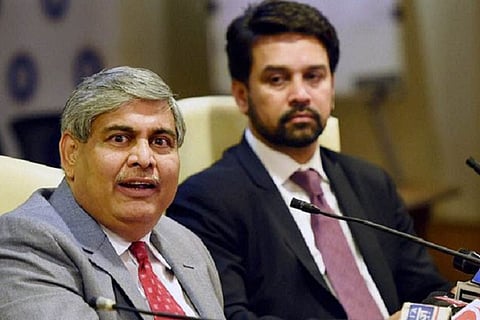

Veturi Srivatsa
Shashankar Manohar always used someone else to do the dirty work for him, making sure his hands are not soiled. The first independent president of the International Cricket Council (ICC) has instincts of a chess player and all his skills can be seen from the way he is making member-countries or his CEO David Richardson take on the Indian cricket board on every contentious issue.
Shashank and Board of Control for Cricket in India (BCCI) president Anurag Thakur, who was secretary when he was the board chief, are today at loggerheads over a slew of issues. Shashank will, as always, be more concerned about the image he has carefully created for himself as a man of utmost credibility and integrity.
Not only Thakur, but most senior members in the board are cut up with Shashank for deserting them when he should have been leading them to take on the Rajendra Mal Lodha Committee and opting for a cushy position as the ICC chief. On assuming charge, he made lofty statements promising to rescind decisions taken during the aborted tenure of his predecessor, Narayanaswamy Srinivasan.
What Shashank is trying to do is exactly what Srinivasan sought to do in collaboration with England and Wales Cricket Board (ECB) and Cricket Australia (CA). The only difference is that the latter tried to form a clique of what is called the Big Three whereas the new ICC chief is trying to cultivate them at the expense of Indian board, which hitherto had its voice heard loud and clear, and even had its way on major issues like the distribution of revenues, review of umpiring decisions and the Future Tours Programme (FTP).
The Indian board is also miffed at not being part of key committees where crucial decisions on revenue distribution and television rights are taken. Sashank's reputation as independent president will rise whereas India's position will be undermined globally.
If Srinivsan's governance model wanted a two-tier Test format keeping the Big Three out of it, doing away with the FTP and giving member-units a free hand in chalking out bilateral tours, the present dispensation is also in favour of two divisions of seven and five teams with a promotion and relegation system.
Already, the top two Test nations -- Pakistan and India -- are divided. The former is in favour of the division and India is opposed to it. If India is disinterested then it will be impossible for the ICC to impose its will unless the other sub-continental boards -- Sri Lanka and Bangladesh -- and the wavering West Indies are on the same page.
Thakur is right: How can you segregate teams from a 10-member Test pool? If the ICC wants to expand the number of Test-playing nations by bringing in Ireland and Afghanistan, it should make them play in their regions to start with. Ireland should play England, South Africa and possibly the West Indies and Afghanistan should hop across Pakistan, India, Bangladesh and Sri Lanka.
How many Tests did Bangladesh play in India? None. The eastern neighbours are going to create history by playing a one-off Test in this country, their first, from February 8-12, 2017 at Hyderabad's Rajiv Gandhi International Cricket Stadium.
In the 16 years since India played its first Test in Bangladesh, it has played seven more in that country. The argument advanced is that Zimbabwe and Bangladesh will make money from their television rights if India visits the two countries whereas if they play in India there are no takers. The TRP ratings fell drastically for the India-South Africa series here last year.
If the idea is to save Test cricket by splitting 12 teams into two groups, it will be counterproductive. The seven top-tier countries can create a market for the Ashes and India-Pakistan series or even Australia-South Africa package and even exploit trans-Tasman rivalry between Australia and New Zealand.
But what about the bottom five? Who would like to promote them? Then, the growth of the game will suffer. It will be reduced to taking the Twenty20 caravan to offshore venues -- like India did by playing the West Indies in Florida, giving all the officials who are likely to be pushed out by the Lodha Committee recommendations a paid holiday.
With Srinivasan taking the Twenty20 format to the lowest level of the cricket pyramid in Tamil Nadu, the districts, with TV coverage, ICC has a reason to worry about the mushrooming of the shortest of the three formats.
A new tribe of cricketers have become gypsies, going around the world playing only Twenty20 cricket and excusing themselves from playing Test cricket.
There appears to be a truce between the new equations in the ICC for the time being, but the chess moves are being worked out. It is to be seen if it is an honourable draw or one of the groups get checkmated. Right now, India seems to have somewhat been cornered.
(Veturi Srivatsa is a senior journalist. The views expressed are personal. He can be reached at sveturi@gmail.com)